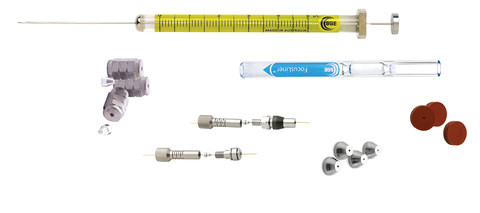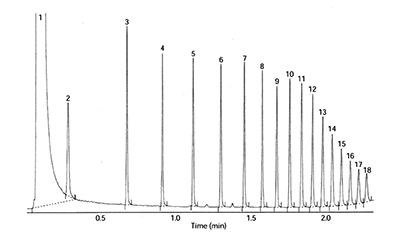Gas chromatography (GC) is a well-known laboratory analysis technique for separating and analysing compounds and is commonly used by scientists and lab managers across multiple industries. GC has been in operation since 1941 and, despite still being in use today, companies are always looking for faster, more accurate and improved techniques.
The latest ultra-fast gas chromatography (UFGC) solution offers analysis that is 5–20 times faster than conventional GC without sacrificing sample capacity or resolution. The following article will look into the principles and practical uses of UFGC, how it differs from conventional GC analysis and key considerations regarding method development when using this technique.
What is UFGC?
The need for conventional GC has been superseded by UFGC; however, to understand why UFGC is now imperative to scientists and lab managers, we also need to look at the differences between GC, fast GC and ultra-fast GC. In any form of gas chromatography, the column size, heating rate and analysis time are key to the way chromatographers work.
A conventional gas chromatograph’s analysis time usually ranges from 15–90 minutes or more. It also uses 15–60 m columns with internal diameters of up to 0.53 µm and heating rates typically ranging from 1–40 °C/min. Fast GC is an improvement on this, using columns with small diameters — typically 0.1 mm — and shorter column lengths (10 m). Excellent resolution and improved speeds are also yielded in comparison with conventional GC, although this can be at the cost of sample capacity.
Despite this, the need for a gas chromatography solution that analyses at a higher temperature with reduced energy consumption and, most importantly, a much quicker analysis time is essential to achieve more accurate results, faster. Ultra-fast gas chromatography uses much shorter columns that have larger internal diameters. This helps to overcome the capacity problems experienced with 0.1 mm columns.
It also allows for faster ramp rates. The column is usually heated in a column compartment without the use of a column oven, with the objective of heating as little mass as possible so that ramp rate increases and cool-down can be accomplished quickly. The cycle times of UFGC are 5–20 times faster compared with a conventional GC and a ramp rate of 1000 °C/min can be achieved. Run times are usually 3–5 minutes.
The column can also be heated to a much higher temperature, with the column’s upper temperature being the limiting factor; yet, the temperature inside the column compartment is typically only around 90 °C. This allows for cool-down times of 30–90 seconds. Rapid cool-down in UFGC requires significantly less energy than in conventional GC. This can be a key benefit when large numbers of samples are being analysed.
UFGC in practice
Types of ultra-fast GC: There are a variety of UFGC systems currently available, including the bundled heater system. This consists of heating a wire and a sensor bundled within a fused silica column. The heating wire resistively heats the column by close approximation to the column itself. This system means that a large amount of mass needs to be heated.
A second option is the EZ flash system. This uses a fused-silica capillary column placed inside a metal tube that is rapidly heated — in turn heating the column. This heating mechanism is parallel to the column and is heated from one end through to the other.
Gas chromatography and ultra-fast gas chromatography innovators such as Ellutia have been exploring the approach of using metal columns, rather that fused silica columns, as the metal columns can be heated directly, which involves heating the minimum possible mass.

Applications and examples of ultra-fast GC systems
UFGC is particularly useful for applications requiring rapid and repeated analysis, such as screening analyses, reaction monitoring and clean-up monitoring. UFGC offers significant advantages for the screening analysis of environmental, petrochemical and pesticide samples as results can be rapidly examined and a quick 1-day turnaround can be ensured. Analysis can then be repeated quickly to confirm the results.
For reaction monitoring, UFGC is used in motor racing to analyse sump oil for fuel breakthrough to help determine engine wear. This technique is also useful for analysing waste streams in pharmaceutical manufacturing, as well as testing chemical permeation breakthrough in warfare suits or other types of protective clothing. Furthermore, for clean-up monitoring, a variety of industries require clean processing equipment and UFGC can be used for the fast determination and repeated analysis of possible residue materials.
An example of this includes the quick Florida TRPH C8-C40 standard analysis. This typically requires around 25 minutes; however, as shown in Figure 1, it can be accomplished in 2.5 minutes with baseline resolution for all peaks.

Figure 1 Ultra-fast GC separation of Florida TRPH C8-C
Advantages of ultra-fast GC
Other advantages of UFGC include peak sharpening, which is achievable using fast ramp rates (Figure 2). The bottom chromatogram (blue) is run at a ramp rate of 40 °C/min. Peaks are well separated, but broad, with a run time of around 4 minutes. In the middle chromatogram (green), the run is started at 40 °C/min with a quick ramp up to 120 °C/min across three peaks. This has the effect of sharpening them. Finally, using UFGC, the top separation (red) was ramped up to 150 °C/min for further peak sharpening with a much shorter run time while maintaining baseline separation.

Figure 2 Peak sharpening using the fast ramp rates achievable with ultra-fast GC
Method development for UFGC
UFGC method development can seem counterintuitive. It is, therefore, important that the basic principles are understood. An application run on a 30 m column can usually be done with equivalent results via UFGC. If a method requires a 60 m column or extra thick films to achieve the required resolution, UFGC may not achieve the needed resolution; but, in that case, a screening method can be developed. Method development can typically involve the following five steps:
- Start with a moderately slow ramp rate, such as 60 °C/min, using hydrogen as the carrier gas at either a constant pressure of 8 psi, or a linear velocity of 50 cm/s and a 7 m thin-film 0.18- or 0.25-µm (internal diameter) column.
- The temperature ramp should be at about 10 °C above ambient. Adjust the temperature range to elute all components in the sample. This can usually be accomplished in 2–3 runs. The top temperature should be as low as possible and peaks of interest that will require good resolution need to be marked.
- The carrier velocity for the single-ramp chromatogram now needs to be adjusted until the best separation of the peaks of interest is achieved (up to 120 cm/s). As mentioned, a constant pressure starting at 8 psi needs to be used. This can then be adjusted up and down in small increments on each run to achieve the best resolution in different parts of the chromatogram. This process will typically require about 10 runs.
- Once the best pressure programme is achieved, the temperature ramping programme can be adjusted in areas of the chromatogram to speed up separation as a whole. Areas of the chromatogram with gaps or no peaks of interest are then to be looked for.
Finally, resolution will begin to deteriorate. Once this point has been reached, the ramp rate will be slightly reduced. Finding this best ramp rate typically takes about 20 runs. Most successful UFGC methods are about 4 minutes, with a 90 s cool-down. The entire optimisation process can take around 35 runs of 5 minutes each.
Future advances of UFGC
Faster multichannel detectors are now being developed that will improve detection capabilities, including time-of-flight mass spectrometry, infrared absorption spectroscopy, atomic emission detection and far-UV absorption spectroscopy. These new advances in detection and fully integrated systems will allow UFGC to be used more commonly.
Summary
UFGC uses columns with much shorter internal diameters, which helps to overcome capacity problems. A UFGC column can be heated to a much higher temperature; however, the temperature inside the column compartment is typically only around 90 °C, which allows for cool-down time of between 30–90 seconds.
With columns certain to be optimised for UFGC within the next 3–5 years and with faster multichannel detectors being developed, scientists will soon have access to fully integrated UFGC systems that will save them time and resources while ensuring optimum results.




